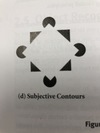Sensation and Perception Flashcards
(35 cards)
Perceptual organization
The ability to use bottom up and top down processing to create a complete picture or idea.
What are the Gestalt Principles?
Law of proximity Law of similarity Law of good continuation Subjective countours Law of closure
Law of proximity
Elements close to one another tend to be perceived as a unit.

Law of similarity
Objects that are similar tend to be grouped together

Law of good continuation
Elements that appear to follow in the same pathway tend to be grouped together. That is, there is a tendency to perceive continous patterns in stimuli rather than abrupt changes

Subjective contours
Have to do with perceiving contours and therefore shapes that are not actually present in the stimulus

Law of closure
When a space is enclosed by a countour it tends to be perceived as a complete figure

Bottom up processing
Data driven
Refers to object recognition by parallel processing and feature detection. Essentially, the brain takes the individual sensory stimuli and combines them together to create a cohesive image before determing what the objet is.
Top down processing
Conceptually driven
Driven by memories and expectations that allow the brain to recognize the whole object and then recognize the components based on these expectations. Top down processing allows us to quickly recognize objects without needing to analyze specific parts
What is sensation?
Similar to transduction. Performed by receptors in the peripheral nervous system. Thought of as a raw signal, which is unfiltered and unprocessed until in enters the CNS
What is perception?
Refers to the processing of sensory information to make sense of insignificance. Perception helps us make sense of the world
Distal stimuli
A stimulus that originates outside of the body. part of the outside world. For example a campfire
Proximal stimuli
The photons that reach the observers rods and cones, as well as the heat the Observer feels.
Proximal stimuli directly interact with and affect the sensory receptors, And inform the Observer about the presence of the distal stimuli
Absolute threshold
The minimum of stimulus energy that is needed to activated sensory system
Psychophysical discrimination testing
The participant is presented with a stimulus that is very slightly and then his asked to identify whether there is a difference in the second stimulus. The difference between the current stimulus and the original is increased until the participant reports noticing a change.
Weber’s Law
States that there is a constant ratio between the changing stimulus magnitude needed to produce a just noticable difference and the magnitude of the original stimulus
Signal detection theory
Focuses on the changing our perception of the same stimuli depending on both internal and external context
the detection of a stimulus depends on both the intensity of the stimulus and the physical/psychological state of the individual
Possible outcomes for signal detection experiment trial

Motion parallax
Objects that are close seem to move past us faster when we go past them. These closer objects also seem to be moving backwards. Objects that are farther away seem to go a lot slower as we go past them. they also seem to be moving forward with us.
Convergence
Objects that are closer make you turn your eyes inward more
Parallel processing
The ability to simultaneously analyze and combine information regarding color, shpae and motion
What do cones detect? What are the 3 types of cones? What wavelengths to they absorb?
Cones are used for color vision and to sense fine details.
Most effective in bright light and come in 3 forms
- Short (S) Also called blue
- Medium (M) Also called green
- Long (L) Also called red

What do rods detect?
Rods only allow sensation of light and dark because they all contain a single pigment called rhodopsin. Low sensitivity. Permit night vision
Describe the Visual pathway
Corniea –> pupil –> Lens –> Vitreous –> retina (rods and cones –> bipolar cells –> ganglion cells) –> optic nerve –> optic chiasm –> optic tract –> lateral geniculate nucleus (LGN) of thalamus –> radiations through parietal and temporal lobes –> Visual cortex in occipital lobe



